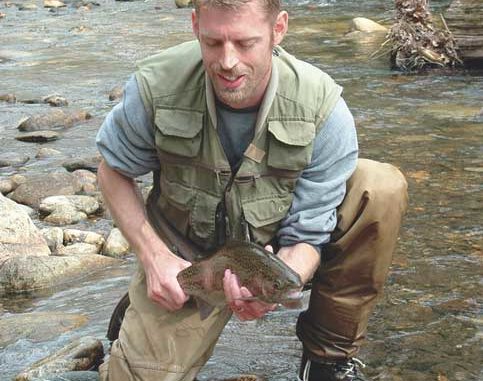
Opening day of the catch-and-keep season always attracts a distinct group of trout fishers.
They won’t be decked out in the latest Orvis fashions, or fishing with top-of-the-line Sage and Loomis fly rods or use hand-made dry flies and nymphs.
Many of them will be wearing the latest fashions from Goody’s or Wal-Mart, fishing with inexpensive Zebco reels, and using red worms, nightcrawlers, wax worms, corn niblets or even marshmallows because just about any type of bait is legal during the catch-and-keep season. These are traditional trout fishers who fish for meat and not for sport.
That’s the beauty of the delayed-harvest trout fishing program. Everyone gets time at the stream.
And if the truth were known, catching a trout with a worm can be equally as satisfying as catching a trout with an artificial fly. It’s merely a matter of perspective.
Delayed-harvest streams change from catch-and-release to catch-and-keep at 6 a.m. the first Saturday in June. If this opening day is anything like previous opening days, limits will be common.
Usually, the fishers who get out early catch a limit within the first hour. Unfortunately, some take their limits home and return for a second and third helping. Wildlife enforcement officers monitor the streams opening day, but violators are difficult to catch unless they’re caught with too many trout in their creels or ice chests.
However, scofflaws are a minority group not held in esteem by any trout fisher. Anyone caught with too many trout in his or her creel faces replacement costs of the fish, a fine, court costs, confiscation of fishing gear and loss of fishing privileges.
John Hall of Sylva, a die-hard bait fisher who lives next to the Tuckasegee River, has no patience with law-breakers.
“If I see somebody taking more than their limit, I’ll call a game warden, and if that doesn’t work, I’ll throw them in the river,” he said.
Don’t weep for all the trout that will be caught opening day. Fishery biologists know that thinning the trout population ensures there’ll be some survivors through the hot months of summer when streams are low, oxygen is at a minimum, and water temperatures are higher than normal.
N.C. Wildlife Resources Commission fishery biologists estimate about half the trout in a delayed-harvest stream are caught during the first two weeks of the catch-and-keep season.
No matter how many trout that bait-fishers catch, plenty of fish will be left.
I fly fish at the Tuckasegee River year-round, and I’ve never had a problem catching fish. I may not catch as many, but I still catch trout. Plus, after the first couple of weeks, fishing pressure returns to normal. The only difference is die-hard fly fishers and die-hard bait fishers share the same waters.
Fortunately, it’s a big stream with plenty of fishing room for everyone.
The delayed-harvest program, initiated in 1992 on a trial basis, is a program for every type of fisher — young or old, experienced or inexperienced. Fishing guides flock to delayed-harvest streams because they can almost guarantee their clients will catch trout.
However, despite its widespread popularity, the program has a few dissenters. Several years ago, one group lobbied for the removal of the delayed-harvest segment of the Tuckasegee River between Webster and Dillsboro. The petition didn’t get enough signers to create any concern.
Seventeen streams and one small lake are spread across 14 counties and are in the delayed-harvest fishing program. The last streams added were the West Fork of the Pigeon River in Haywood County and the East Fork of the French Broad River in Transylvania. Both streams were designated delayed-harvest waters in 2002.
Sections of the North Toe River in Mitchell County and the Reddies River in Wilkes County will be added to the delayed-harvest fishing program beginning July 1, 2008. The North Toe section includes 2.3 miles of stream that flows through the town of Spruce Pine. The Reddies River is a mile-long section that runs through the town of North Wilkesboro.
Delayed-harvest waters are under catch-and release regulations from Oct. 1 until the first Saturday in June. The streams then revert to catch-and-keep regulations until Sept. 30.
From June through September, streams are regulated under hatchery-supported rules. Delayed-harvest streams are generously stocked in March, April and May and again in October and November.
Beginning with the 2008-09 season, fishers under 16 years of age will get dibs at fishing delayed-harvest waters when the streams revert to catch-and-keep fishing. The young fishers will have the streams to themselves the opening Saturday from 6 a.m. until noon. After that, the streams open to all fishers.
The WRC has clarified the types of lures and bait that can be legally used at catch-and-release streams. Lures with any type of attractant designed to appeal to a fish’s sense of smell or taste will be prohibited at all delayed-harvest waters during the catch-and-release season and at most wild trout waters.
Some fishers had the incorrect idea that baits such as Berkley Power Bait and similar products could be used because they were “artificial” baits. These baits are legal only at hatchery-supported waters and at wild trout/natural bait streams.
Other changes in trout fishing regulations approved by the WRC included changing the designation of the West Fork of the Tuckasegee River and Buff Creek in Jackson County from hatchery-supported streams to wild trout/natural bait streams. Big Creek in Macon County was changed from hatchery-supported to wild trout. Portions of Laurel Creek in Watauga County and portions of Dugger Creek in Wilkes and Watauga counties were changed to catch-and-release/ artificial lures only streams.
All new changes in regulations go into effect July 1.




Be the first to comment